A projector is an excellent way to get big screen entertainment in your home theater, but not every model is designed to compete with ambient light. The best projector for bright rooms is one with a powerful lamp that can keep the contrast high and the colors saturated, no matter what light conditions you’re working in.
All of the projectors on this list are designed for bright rooms, with a brightness rating of at least 4,000 ANSI lumens. While the Epson EpiqVision Ultra LS800 is our top pick overall (>>> Find it on Amazon), each of the projectors below has its strengths. Let’s take a closer look at which one’s the best in some key areas.
Best Projector for Bright Rooms in 2023 – Top Picks:
- ViewSonic PX748-4K
- Optoma UHD38
- Epson Pro EX9240
- Optoma GT1090HDRx
- Epson EpiqVision Ultra LS800
- Optoma HD39HDRx
| ViewSonic PX748-4K | Optoma UHD38 | Epson Pro EX9240 | Optoma GT1090HDRx | Epson EpiqVision Ultra LS800 | Optoma HD39HDRx | |
|---|---|---|---|---|---|---|
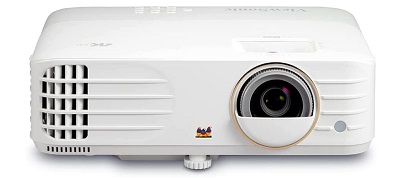 |
 |
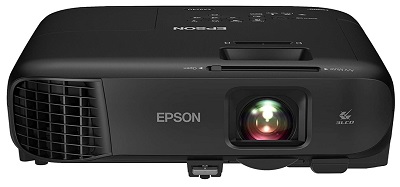 |
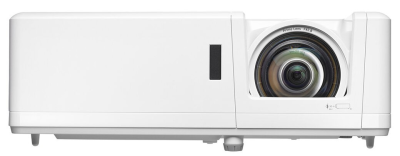 |
 |
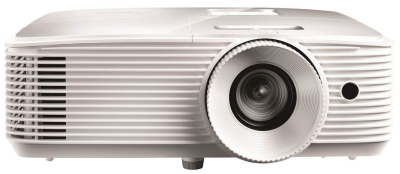 |
|
| Resolution | 3840x2160 | 3840x2160 | 1920x1080 | 1920x1080 | 3840x2160 | 1920x1080 |
| Brightness (Lumens) | 4,000 ANSI | 4,000 ANSI | 4,000 ANSI | 4,200 ANSI | 4,000 ANSI | 4,000 ANSI |
| Contrast Ratio | 12,000:1 | 1,000,000:1 | 16,000:1 | 300,000:1 | 2,500,000:1 | 50,000:1 |
| Throw Distance | 3.2' - 24.7' | 4.0' - 32.7' | 4.7' - 28.8' | 1.3' - 10.9' | 0.9' - 1.8' | 4.2' - 24.4' |
| Screen size | 30" - 301" | 33" - 300" | 30" - 300" | 37" - 301" | 80" - 150" | 40" - 300" |
| Speakers | 10.0 Watts Mono | 10.0 Watts Mono | 16.0 Watts Mono | 10.0 Watts × 2 | 5.0 Watts × 2 | 10.0 Watts Mono |
| Today's Best Price | BHPhotoVideo.com | BHPhotoVideo.com | Check on Amazon | BHPhotoVideo.com | ProjectorScreen.com | BHPhotoVideo.com |
Video Quality
For presentations, a WXGA resolution will be plenty sharp enough for legible text and clearly visible graphics, so the projector’s resolution isn’t as much of a factor.
If you plan to watch movies or play graphic-intensive games, however, anything lower than full HD will look a bit blurry and soft compared to what you’re used to.
If your main concern is picture quality, you’ll want to go with a 4K projector. The Optoma UHD38 is a strong performer, with a high image contrast that brings equal detail to the darker areas of the screen.
The SuperColor feature of the ViewSonic PX748-4K puts it slightly ahead, especially since it matches the Optoma in contrast and image definition. For the absolute best picture, however, the combination of Ultra HD resolution and 3-chip color of the Epson LS800 puts it in the lead.
Best video quality: Epson EpiqVision Ultra LS800
Throw Distance
Most of these projectors use a standard throw distance. In layman’s terms, that means you’ll need a good amount of space between the lens and the screen—anywhere from 8 to 12 feet for a 100” image, depending on the projector.
For smaller spaces, the ultra-short throw of the Epson LS800 makes it the best choice, able to produce images as large as 150” diagonally from less than two feet away. The Optoma GT1090HDRx is another short-throw option.
While it needs a bit more space than the Epson, it fills a 100” screen from around four feet away, less than half the distance of a standard throw projector.
Shortest throw distance: Epson EpiqVision Ultra LS800
Input Lag and Gaming
All projectors add a delay between your input and what you see on the screen. This is measured in milliseconds, and most people watching TV or movies won’t even notice it.
For gaming, though, it can be very distracting, and most gamers look for an input lag of 30ms or lower when they’re shopping for a projector.
There are three projectors on this list that have a measured input lag in the single-digits.
The Optoma GT780 measures around 8.4ms, while the ViewSonic PX748-4K and Optoma UHD38 measure an impressive 4.2ms.
Those last two also have a 240Hz frame refresh rate in 1080p, so they have a processing speed to match their user responsiveness.
Best for gaming: ViewSonic PX748-4K, Optoma UHD38
Portability
While none of these projectors are especially bulky, if you need to travel with it a lot, it helps to find the lightest, slimmest one you can.
The Optoma HD39HDRx weighs less than 10 pounds and has a slim profile under 5 inches tall, giving it versatility to take your entertainment on the road.
Most portable projector: Optoma HD39HDRx
ViewSonic PX748-4K
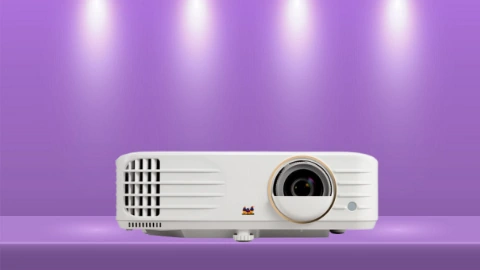
Pros
- Sharp true 4K resolution
- SuperColor technology
- Low input lag and high frame rate
- Automatic keystone correction
- Compatible with LAN-controlled home automation systems
- HDMI and USB-C connectivity
Cons
- Streaming dongle must be purchased separately
- Not ideal for small spaces
The ViewSonic PX748-4K is a versatile and powerful projector capable of fulfilling all your home entertainment needs. Its sharp Ultra HD resolution and HDR support give users a sharp, accurate image for movies and TV shows.
The SuperColor enhancement is another great feature for bright spaces, optimizing the color to match your space’s light level. For gamers, the high 240Hz refresh rate and single-digit input lag mean no delays or other issues that will impede your play.
The connectivity of the ViewSonic PX748-4K is just as versatile as its performance. Along with dual HDMI inputs, it supports content from devices through USB-C, and can charge your phone, tablet, or gaming system while you’re using it to play games or movies.
It can also be connected to networks and home automation systems through LAN or the 12V trigger input, good news for smart home owners.
Setting up the ViewSonic PX748-4K is fairly easy. It does have a standard throw distance, so you’ll need around 8-10 feet for a 100” screen.
This limitation aside, it has a good array of alignment options, including automatic keystone correction, an anti-warp tool, and 1.3x manual zoom. Click here for our more in-depth ViewSonic PX748 review.
Optoma UHD38
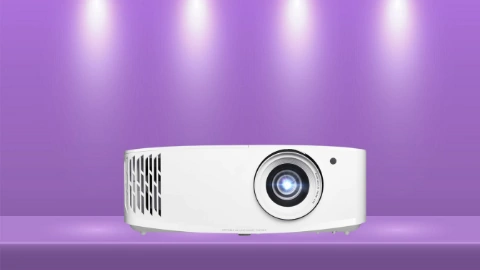
Pros
- Sharp 4K resolution
- High dynamic contrast with HDR10 support
- Low lag is ideal for gamers
- Full 3D compatibility
- Versatile connectivity
Cons
- Needs a larger room for a big image
- Limited image alignment options
The Optoma UHD38 is another option that’s perfect for gamers. It boasts an input lag as low as 4.2ms, with a 240Hz frame rate in full HD for smooth, blur-free visuals that let you get immersed in your game.
The high dynamic contrast is another plus for gamers, helping you see every detail even in dark areas of the screen.
Home theater users will find as much to love about the Optoma UHD38. It has a native 4K resolution to go with that high dynamic contrast, and is compatible with visual technology like HLG and HDR10.
Along with that, it has full support for 3D content, so you can truly recreate the movie theater experience at home.
As far as the set-up, the Optoma UHD38 isn’t difficult to install, though you will need a larger room for it. You’ll also need to be fairly precise when you install the ceiling-mount.
While it has a wide keystone correction for squaring the image geometry, its zoom is narrow and it lacks features like lens shift that can help fine-tune the alignment. Click here for our more in-depth Optoma UHD38 review.
Epson Pro EX9240
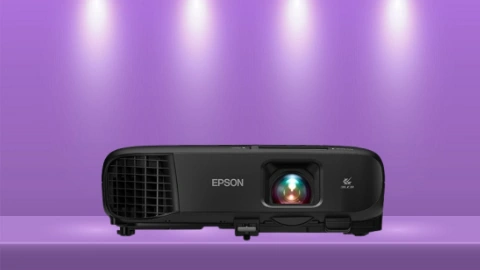
Pros
- Vibrant color with no rainbow effect
- Screen mirroring through Miracast
- Low enough lag for most gamers
- Easy installation and image alignment
- Automatic image skew correction
- Good speaker output for business or classroom use
Cons
- No 4K capability
- High fan noise in higher performance modes
You don’t need to spend a fortune to get a projector for a bright space. The Epson Pro EX9240 is designed for use in conference rooms, classrooms, and other group settings, and it excels in this context.
Its full HD resolution means crisp graphics and legible text, even from the back row, while the 16-watt speakers have enough power to make sure the whole room hears video presentations or Zoom calls.
The Epson Pro EX9240 can also work in a home theater. Its lack of 4K support is its main limitation in this context, though it otherwise produces a detailed, colorful image.
The 3-chip LCD display provides a smoother color gamut than 1-chip designs. While it’s not the fastest projector on the list, its input lag is still low enough most gamers won’t have an issue.
We also appreciate how fast and easy the Epson EX9240 is to install. It has a sensor on the front to analyze the picture and automatically square it to the screen.
There’s also a slider and 1.6x zoom for manual fine-tuning. You’ll also get more ways to connect your content devices, with support for Miracast in addition to dual HDMI ports.
Check our more in-depth Epson Pro EX9240 review.
Optoma GT1090HDRx
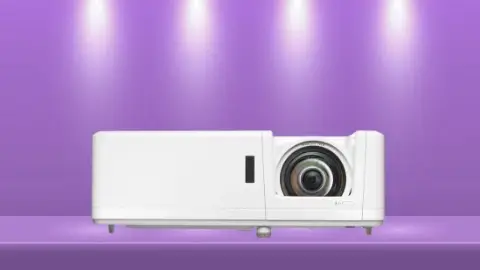
Pros
- High-contrast and colorful full HD image
- Low input lag (8.2ms)
- Short throw distance
- Low maintenance with IP6X dust protection
- Supports 360° and 24/7 operation
- Good sound from built-in speakers
Cons
- 4K content downscaled to 1080p
- No wireless connectivity
The DuraCore laser light source in the Optoma GT1090HDRx isn’t just powerful, it’s also durable. It’s maintenance-free and lasts up to 30,000 hours, producing a consistently high brightness throughout its lifespan.
This is paired with a DLP display that has a high dynamic image contrast and 10-bit color for lifelike full HD performance.
The Optoma GT1090HDRx can be used just about anywhere. Its short-throw lens can produce a clear image with as little as 16” of distance. Its 2D keystone correction, including automatic vertical correction, lets you quickly square the image for your screen or surface.
It can also be installed at any angle, and has high-quality built in speakers so you may not even need to connect external sound sources to use it.
The GT1090HDRx is also a solid choice for gamers. It has a measured input lag as low as 8.2ms, fast enough for even competitive players. You can also use it for 3D movies, with support for three 3D formats (frame packing, side-by-side, and top-bottom).
In short, it can handle just about all of your entertainment needs.
>>> Check our full Optoma GT1090HDRx review.
Epson EpiqVision Ultra LS800
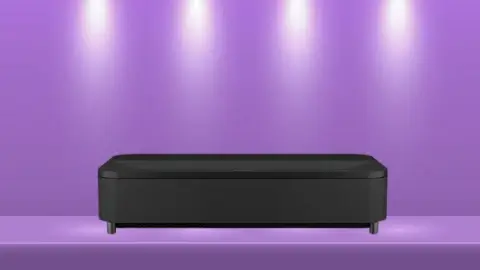
Pros
- Sharp and colorful True 4K display
- 3LCD color with no rainbow effect
- Low enough lag for most gamers
- Ultra-short throw distance
- Integrated Android TV interface with voice control
- Good sound from built-in speakers
Cons
- Costs more than other options
The Epson EpiqVision Ultra LS800 is an all-in-one home entertainment machine. The integrated 2.1-channel Yamaha sound system fills any room with high-quality audio, no need for external speakers.
It also has built-in Wi-Fi support and an Android TV interface, letting you mirror content through Chromecast or watch streaming services like Hulu and Disney+ right on the projector.
This is another projector that’s very flexible in terms of its space. It only needs a few inches of distance to get a clear picture, and can fill a 100-inch screen from just over a foot away.
Controlling it is easy, too, with the option of Google Assistant voice control as well as the included backlit remote.
Topping it all off, the Epson LS800 is one of the best options for overall picture quality. This starts with its true 4K resolution and 10-bit real time video processing, ensuring the picture is sharp and smooth.
The 3LCD color with 10-bit HDR processing adds even more realism and depth. Gamers can use it, too, with a lag time under 20ms that will satisfy all but the most serious players.
>>> Our more in-depth Epson EpiqVision Ultra LS800 review
Optoma HD39HDRx
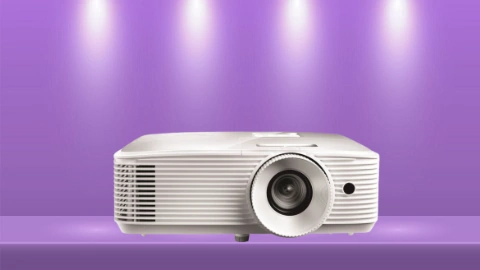
Pros
- Full HD image with HDR10 support
- Great for gaming
- Built-in speakers
- Good variety of inputs for content sources
- Excellent value
Cons
- Longer throw distance
- Maximum resolution of Full HD
The Optoma HD39HDRx is one of the best projectors for a bright space you can get for under $1,000.
It uses similar DLP display technology to other Optoma projectors, with HDR10 support that give it a high image contrast and accurate colors. The customizable picture modes let you easily adjust the image to your content and space.
This is also one of the best gaming projectors you’ll find in this price range. Not only does it have a single-digit input lag, but it also has a 120Hz frame refresh rate, ensuring smooth action for your entire playing session.
Now, you will want to use the Optoma HD39HDRx in a fairly large space. It has a standard throw distance, meaning you’ll need somewhere between 8-11 feet for a 100-inch image, depending on how you set the 1.3x zoom.
Its alignment features are also limited, with just vertical keystone correction and manual focus controls, which can make it tricky to set up in some spaces.
So What’s the Best Projector for Bright Rooms?
Based solely on performance, the Epson EpiqVision Ultra LS800 excels in just about every category, with an ultra-short throw, low lag, built-in streaming, and exceptional image quality (>>> Check on ProjectorScreen).
It’s also on the pricier side, however, which could make a model like the Optoma HD39HDRx more appealing for budget-conscious consumers. It all depends on what you need from your projector and how you plan to use it.
Whichever projector you go with from the list above, though, you can count on never needing to turn the lights off to enjoy your entertainment.